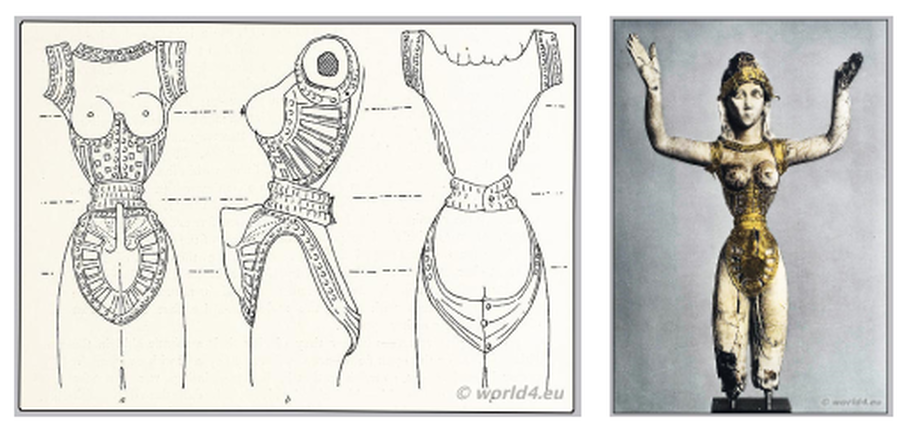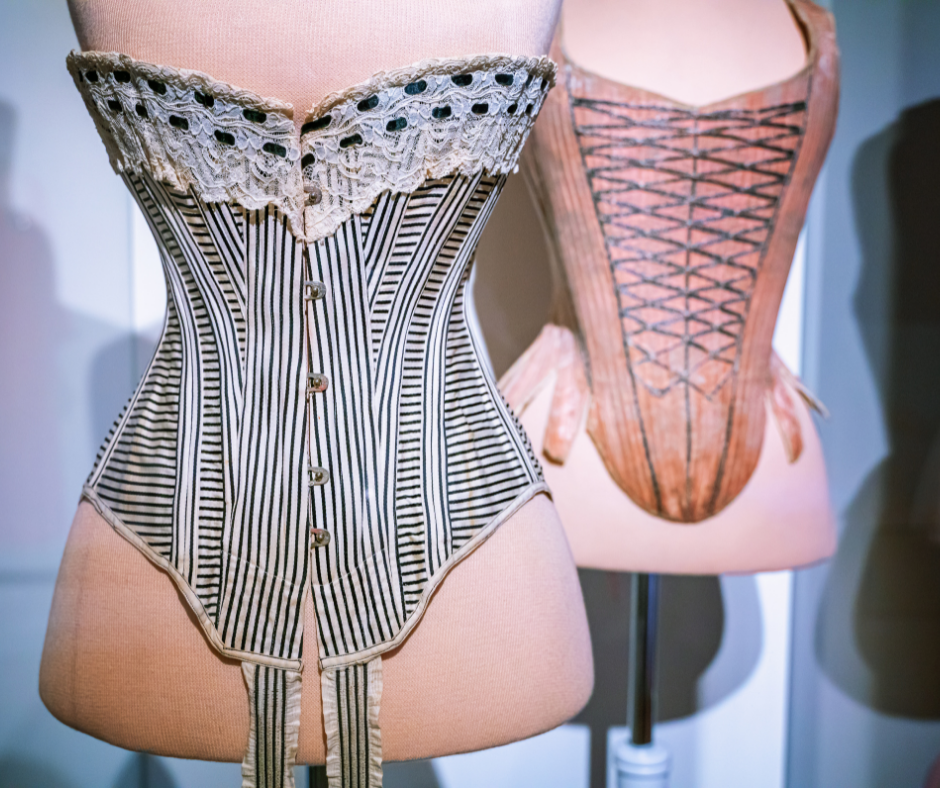Of course, we’ve all seen women walking the lanes at the Renaissance festival in gorgeous court gowns, shimmery fairy costumes, and simpler merchant-class dresses. But perhaps there is no more ubiquitous clothing item at the RenFaire than the corset. Curvy, boned, and in materials from silk to leather, the Victorian corset has become the costume piece most often worn by women at the faire, so recognizable that even the TV show Big Bang Theory cast proclaimed after their day at the festival:

Howard: Renaissance fairs aren’t about historical accuracy, they’re about taking chubby girls who work at Kinko’s and lacing them up in corsets so tight their bosoms jump out and say “Howdy”.
Sheldon: Bosoms would not have said “Howdy” in the 15th century. If anything, they would’ve said “Huzzah”.
Howard: I don’t care what the bosoms say, Sheldon, I just want to be part of the conversation.
But how did this garment become de rigeur? Costumer Vivian Orozco explores this gorgeous garment.
The word “corset”, in modern day, has become a colloquial, catch- all term for any undergarment that binds the bust and the waist into a specific silhouette. However, the word itself originated in the 14th century and is French in origin, meaning “A kind of laced bodice.” Its more modern meaning, as a “stiff supporting and constricting undergarment for the waist, worn chiefly by women to shape the figure,” dates from the 18th century. Corset, however, is not the only term used to describe a binding undergarment. If you have ever heard the terms “pair of bodies”, “jumps”, or “stays”, know that they all refer to different variants of what we know collectively as corsets today. The garment is far older than the terms, with early forms of the underbust corset dating back to early Minoan civilization.

The corset itself represents a fundamental shift in the concept of clothing and tailoring; instead of shaping clothes to the body, as had been done throughout the Medieval and Renaissance periods, the body began to conform to the fashionable shape of the clothing worn. Instead of the kirtle, the pair of bodies was used to alter the figure, and this idea would eventually lead to the evolution of stays, jumps, and into the poster child for corsetry, the Victorian corset.
What is the difference between all of these garments and why is it that for Renaissance Faires, Victorian corsets are a staple of “period” fashion, despite the fact that the garment existed well after the Renaissance? As most festivals are set in the Renaissance or Medieval era, one must understand that what was fashionable during the period was far different than what we see in Festivals today, and from there, explore how society collectively came to this choice in fantasy/steampunk/historical wardrobe.
The first major difference is in overall look, or what is referred to as the silhouette. The fashionable silhouette of the late Renaissance period, most notably, Tudor and Elizabethan, was a cylindrical silhouette, with the bustline both flattened and raised – the idea of a small waist had not yet become popular in fashion, secondary to the preferred cylindrical silhouette of the period.

During the Tudor and Elizabethan periods, the “pair of bodies” was what was used to achieve this cylindrical silhouette. Contrary to the Victorian corset, the pair of bodies could be used as both an undergarment or an outer garment, having originally evolved from the early 15th century kirtle. There are many examples of bodies from these centuries that have detachable sleeves. Whalebone was frequently used in bodies to maintain their stiff appearance. Bents, made from reeds, was also a common stiffener. A busk, typically made of wood, horn, ivory, metal, or whalebone and carved into a thin, knife-like shape, was added to stiffen the front of the bodice. The busk was inserted into a pouch in the front of the bodice, then fastened and held into place by ribbon. This method allowed the piece to be easily removed and replaced. The stomacher, a stiff, V-shaped structure often decorated and embroidered, was attached to the front of the pair of bodies to complete a lady’s attire.
As we move into the 17th and 18th centuries, we see the pair of bodies evolve into what we know as stays and jumps, in accordance with the changing fashionable silhouette. The silhouette during this time transformed from a cylindrical torso shape to a stiff, inverted cone shape. It was fashionable to create a contrast between a rigid, quasi-cylindrical torso above the waist and heavy, full skirts below. The primary purpose of stays was to raise and shape the breasts, tighten the midriff, support the back, improve posture to help a woman stand straight, with the shoulders down and back, and only slightly narrow the waist, creating a “V” shaped upper torso over which the outer garment would be worn.
However, “jumps” of quilted linen were also worn instead of stays for informal situations. Jumps were softer, significantly less boned or sometimes completely unboned, bodices or soft stays which still provided some bust support, but did not shape the body into such an ‘elegant’ cone shape. They laced up the front, and thus were easier for a lady to put on and take off by herself. Jumps became more popular at the end of the century with the change in fashion from the elaborate 18th century styles to the softer neoclassical styles.
Corsetry transformed again in the late 18th century and early 19th century- this is where short stays, bust bodices, and demi-corsets come into prominence, and when the waistline dropped in the 1830’s, the corset became an undergarment. With the invention of the front-fastening busk by Joseph Cooper in 1849, the silhouette would transform into what we know today as the Victorian corset. This period is when we see the hour glass shape come into fashion, and we see tight lacing begin to gain popularity.The corset no longer ended at the hips, but flared out and ended several inches below the waist, and in some cases, spiral steel replaced whalebone and reed to better curve the figure.
Knowing the difference in the silhouettes of each period, the question then becomes- why are so many people choosing to wear Victorian corsets rather than garments that are closer to the period that Renaissance Festivals advertise to portray? When a pool of festival patrons and vendors were asked this very question, the answers were very enlightening. Many patrons had no idea that the other silhouettes existed, others felt that the Victorian corset had more aesthetic appeal than its traditional counterparts, and still others felt that Hollywood glamourized the Victorian corset as a part of fantasy/Renaissance fashion.
Maire Kenny, a vendor that sells period styles as well as Victorian corsets at many festivals, expressed the following: “ In my experience with patrons, it’s less about historical accuracy and more about the shape. The victorian or vanity corset, while still functional as a support garment, provides an extra bit of detail that would normally be seen with a stomacher. People also want to wear less, so this garment has become more popular, especially the variety that are worn without shirts/chemises. Jumps and bodices tend to be popular for people who want more ease of movement.”
It is the author’s theory that a combination of fashionable silhouette that is closer to our modern aesthetic, something that is easier for one to wear overall, and a collective consciousness that considers anything over a century old as “Renaissance”, and the lack of access to information on period garments has resulted in this fashion phenomenon.
However, that doesn’t mean wearing a Victorian corset to a Renaissance Festival is a fashion faux pas. Renaissance Festivals are designed to be fun, and one should wear whatever one wants, likes, and is most comfortable in. It is simply an interesting point of note that what was once considered underwear to some is now considered a staple of fantasy, period, and steampunk fashion.
V.O.

Vivian Orozco is a historical tailor, artist, film maker and cosplay enthusiast from South Florida, currently living in sunny Los Angeles. Instagram: @vixiebelle
If you’re interested in more tips on fitting and lacing your corset, faire favorite Corsets by Casta Diva has great information! Or find them at Texas Renaissance Festival • Bay Area Renaissance Festival • Sherwood Forest Faire • Georgia Renaissance Festival • Pennsylvania Renaissance Festival • Bristol Renaissance Festival • Louisianna Renaissance Festival • New York Renaissance Faire.

Great information! Thanks for this.
I always assumed that the Victorian silhouette at Ren Fest was simply because it was the cheapest, most available option for the majority of people.
I like this explanation, though.
I would love to learn more history from this author!
LikeLiked by 1 person
We definitely feel the same, and Vivian will be bringing more costume history to our readers. We hope you’ll read some more in the future!
LikeLiked by 1 person